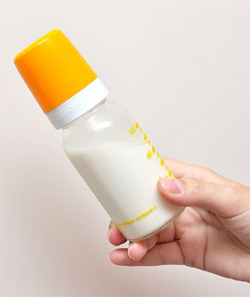
Researchers also found that most new mothers have learned about breast milk sharing through friends or relatives — with a small number sharing milk with both — but few women may be discussing the option with their physician before doing so.
“We’re trying to play catch up to understanding something that thousands of women are already doing so that healthcare professionals and women can make better decisions for themselves and their babies,” said Sarah Keim MA, MS, PhD a principal investigator in the Center for Biobehavioral Health at The Research Institute at Nationwide Children’s Hospital. “Our study found that friends and relatives and the media are playing a huge role in education and dialogue around breast milk sharing, but that healthcare practitioners are being left out. And that’s concerning, because there are risks involved with feeding your baby breast milk from another woman — friend or stranger.”
The American Academy of Pediatrics has issued a policy on the dangers of feeding preterm babies unpasteurized milk, but there are no current guidelines for peer to peer sharing of breast milk — leaving professionals with little to go on. There are thousands of women who are unable to breast feed, but still want to give their babies the benefits of breast milk, prompting the growth of an unregulated industry of breast milk buying, selling and trading.
Other studies conducted by Keim and her team have shown that most breast milk purchased through the internet is often contaminated with cow’s milk, chemicals, or disease-causing bacteria. Non-profit milk banks in the United States do a rigorous job of screening donors and purifying breast milk, but because there is so little of it being donated, the vast majority is given to hospitalized premature babies. At four dollars an ounce, milk bank breast milk is very expensive, prompting some women to turn to the internet to purchase milk from strangers, or seek it from friends or relatives.
Keim did not analyze the purity of breast milk shared from friends or relatives of those who participated in the study, and says that there’s currently not enough information on the potential benefits of breast milk sharing between strangers, friends and relatives to outweigh the risks.
“We just don’t have enough data to advise women on the risks of breast milk sharing, and that’s one of the reasons why this research is so important,” said Keim, who is also an Assistant Professor of Pediatrics in The Ohio State University College of Medicine and of Epidemiology in the College of Public Health. “If you have difficulty with breast feeding, seek help right away, and if breast feeding isn’t an option, work closely with your baby’s pediatrician to come up with a plan for feeding your baby that meets their unique needs. Some babies have difficulty growing or have medical conditions that require different strategies.”
Educated women more likely to donate or use donated breast milk. For the study, 500 new mothers in central Ohio were surveyed about their knowledge of breast milk sharing and if they had used donated milk, or donated milk themselves. A subset of women who took the survey was also interviewed. Educated, higher income women were more likely to be aware of breast milk sharing and consider either using another woman’s breast milk, or donating her own breast milk for another child. Less educated, lower income women were less likely to be aware of the practice.
Seventy-seven percent of those surveyed were familiar with breast milk sharing. The majority of women familiar with breast milk sharing (67%)) said that they would consider the health of the mother first before using donated milk, indicating that the remaining respondents (33%) didn’t consider the mother’s health a priority. Twenty-seven percent of the women surveyed said that they hadn’t thought about the concept of safety when it came to using another woman’s breast milk.
“This is the first study to look at the characteristics of women who are more or less likely to engage in the practice of breast milk sharing, and can help give physicians a starting point for dialogue with their patients,” said Keim.
Approximately four percent (n=19) of those surveyed had either used donated breast milk or provided milk to another child. None of the women surveyed had purchased breast milk over the internet. A little less than half of the women who used donated milk or shared their own milk did so with friends and relatives. Forty-five percent of women surveyed reported producing more breast milk than their child needed.
Keim says that number, coupled with the high level of awareness about breast milk sharing means that there is room for educating women about donating extra breast milk.
“I’ve talked to so many women that end up with a freezer stocked with breast milk and they aren’t sure what to do with it, and they think that donating is difficult,” said Keim.
“The milk banks actually make it very easy for women to donate by handling all expenses with the shipping and testing. It only takes a few ounces to feed a premature baby, and it makes a huge difference.”
This study was on part of Keim’s larger “Moms2Moms” project looking at breast milk sharing patterns, attitudes and practices. She hopes that her work will aid in the development of national recommendations and standards.
“In the absence of any guidelines, healthcare professionals must increase their awareness of the online milk buying process and breast milk sharing so that they can counsel their patients on risks and safety issues. It’s definitely also an opportunity for healthcare professionals to tell women that once they’ve fed their baby, they could save the life of another by donating their extra breast milk.” The study was published in Breastfeeding Medicine and conducted at Ohio State University Center for Clinical and Translational Science.